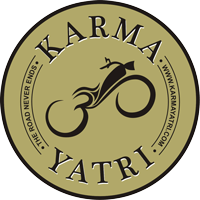Motorcycling In India
Road tripping : The road can be your best friend or your worst enemy, so we advise you to always ride keeping in mind your safety, and of other people travelling with you. It’s best to stick to your side of the road, avoid overtaking , keep in pace with the group and follow hand signals from the road captain. The terrain gamut goes from excellent tarmac to dirt , large stream crossings, steep inclines and declines, sand, gravel, one lane paths, mountain passes, and loads of dust , but all this is not without its own fun.
High Altitude : Elevations range from 3300 metres at it’s lowest (Leh) to 4000 + metres at most parts so it’s safe to say you will be riding and staying at high attitudes. The possibility of AMS or Acute Mountain Sickness is something you have to prepare for. We recommend consulting your doctor with regards to any allergies you may have to medication used for AMS. Avoid physical activity on Day 1 and monitor your body for any signs of discomfort. Avoid drinking alcohol on the trip as it aggravates underlying symptoms of AMS.. That being said getting a good night’s rest every night, eating garlic with your food or raw 
Facilities: We will be spending our nights in comfortable hotels and nature camps for the duration of the trip . Power cuts are not very uncommon and connectivity to phone and internet are sketchy to non-existent in some parts. Whilst we provide all meals, snacks, beverages and alcohol during the course of the trip are on your tab. Make sure all your electronic devices are charged and maybe a spare battery and data cards for your camera are good idea.
Temperature: Average day time temperature would be between 15- 25 Deg C with bright sunshine and crystal clear blue skies. Though the weather can change unexpectedly on this route. Night time temperatures will plummet 15 deg to about 5 – 6 Deg C. just before dawn.
KIT LIST
Motorcycling In India
Road tripping : The road can be your best friend or your worst enemy, so we advise you to always ride keeping in mind your safety, and of other people travelling with you. It’s best to stick to your side of the road, avoid overtaking , keep in pace with the group and follow hand signals from the road captain.
The terrain gamut goes from excellent tarmac to instance of some dirt/off roads , two lane highways, one lane paths, Ghat roads, and loads of dust , but all this is not without its own fun. Facilities We will be spending our nights in comfortable hotels and home stays for the duration of the trip . Phone and internet may not be available in some areas but this is not constant.
Whilst we provide all meals. The snacks, beverages and alcohol during the course of the trip are on your tab. Make sure all your electronic devices are charged and maybe a spare battery and data cards for your camera are good idea. Temperature The winter season in India is the ideal time to visit the south, as the humidity is relatively low, day temperatures do not climb too high and the nights are pleasant and cool to cold in some areas. Some occasional light rain showers are not uncommon in certain areas; though rare. The temperature in the day can climb up to 30 degrees centigrade and in the nights it drops to a pleasant 17 – 25 degrees. In some cases it can drop a little lower.
KIT LIST
Motorcycling In India
You should be up to date on routine vaccinations while travelling to any destination. Some vaccines may also be required for travel. These vaccines include measles-mumps-rubella (MMR) vaccine, diphtheria-tetanus-pertussis vaccine, varicella (chickenpox) vaccine, polio vaccine, and your yearly flu shot. Latest updates on vaccinations can be obtained from your local clinic or hospital.
Motorcycling In India
Please take note that visa requirements for certain countries may change from time to time. It is advisable that you check with your directly with destination country’s Embassy or High Commission before booking.
What sort of protection/coverage does a travel insurance for Motorcycling In India cover for you? Some of the coverage that you should expect is as below:
….and other types of coverage as well.
Here are other examples that might NOT be covered in travel insurance:
For more information on the inclusions & exclusions of travel insurance coverage, contact your travel agent.
